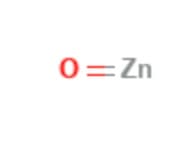Zinc Oxide

Summary: A broad-spectrum mineral UV filter with additional skin-soothing and antimicrobial benefits.
Published on: 22/04/2025
Zinc oxide is a white, inorganic compound used extensively in topical skincare, most notably as a broad-spectrum UV filter. It is a mineral sunscreen agent that reflects and scatters both UVA and UVB radiation, protecting the skin from sunburn and long-term photodamage [1]. In addition to its sun-protective properties, it has recognized anti-inflammatory effects [2].
UV Protection
Zinc oxide functions as a physical (mineral) sunscreen, forming a protective barrier on the skin’s surface that blocks and scatters UV rays. It provides broad-spectrum protection, covering both UVB (290–320 nm) and UVA (320–400 nm) wavelengths [1]. Unlike chemical filters, zinc oxide starts working immediately after application and is photostable — it does not degrade significantly upon sun exposure [3].
Micronized or nano-sized forms of zinc oxide are commonly used to reduce the white cast on skin without compromising UV protection. Studies have confirmed that these particles remain on the skin's surface and pose minimal risk of systemic absorption when used in cosmetic formulations [4].
Anti-Inflammatory and Wound Healing Properties
Zinc oxide has been shown to reduce inflammation, making it useful in treating skin irritation, diaper rash, and acne lesions [5]. It promotes epithelialization and granulation tissue formation, supporting skin regeneration in wound care settings [6]. Some studies also suggest that zinc oxide has antimicrobial properties, helping reduce bacterial colonization in compromised skin [7].
Safety Profile
Zinc oxide is considered safe and well-tolerated, even for sensitive skin. The Cosmetic Ingredient Review (CIR) and the U.S. FDA classify zinc oxide as safe for use in OTC sunscreen products at concentrations up to 25% [8]. Studies show negligible systemic absorption, even when applied to damaged skin [4].
Conclusion
Zinc oxide is a highly effective, broad-spectrum UV filter with additional benefits for inflamed or irritated skin. Its safety, photostability, and low risk of systemic exposure make it a reliable option in both daily sun protection and therapeutic skincare.
References
-
Beasley, D. G., & Meyer, T. A. (2010). Characterization of the UVA protection provided by avobenzone, zinc oxide, and titanium dioxide in broad-spectrum sunscreen products. American Journal of Clinical Dermatology, 11(6), 413–421.
https://pubmed.ncbi.nlm.nih.gov/20806994/ -
Ågren, M. S., Phothong, N., Burian, E. A., Mogensen, M., Hædersdal, M., & Jorgensen, L. N. (2021). Topical zinc oxide assessed in two human wound-healing models. Acta Dermato-Venereologica, 101, adv00400.
https://www.ncbi.nlm.nih.gov/pmc/articles/PMC9367036/ -
Mitchnick, M. A., Fairhurst, D., & Pinnell, S. R. (1999). Microfine zinc oxide (Z-Cote) as a photostable UVA/UVB sunblock agent. Journal of the American Academy of Dermatology, 40(1), 85–90.
https://doi.org/10.1016/S0190-9622(99)70532-3 -
Gulson, B., et al. (2010). Small amounts of zinc from zinc oxide particles in sunscreens applied outdoors are absorbed through human skin. Toxicological Sciences, 118(1), 140–149.
https://academic.oup.com/toxsci/article/118/1/140/1658967 -
Gupta, M., Mahajan, V. K., Mehta, K. S., & Chauhan, P. S. (2014). Zinc therapy in dermatology: a review. Dermatology Research and Practice, 2014, 709152.
https://www.ncbi.nlm.nih.gov/pmc/articles/PMC4120804/ -
Ågren, M. S. (1990). Studies on zinc in wound healing. Acta Dermato-Venereologica. Supplementum, 154, 1–36.
https://www.medicaljournals.se/acta/content/issue/70-154 -
Reddy, K. M., et al. (2007). Selective toxicity of zinc oxide nanoparticles to prokaryotic and eukaryotic systems. Applied Physics Letters, 90(213902).
https://aip.scitation.org/doi/10.1063/1.2742324 -
Kim, K.-B., Kim, Y. W., Lim, S. K., Roh, T. H., Bang, D. Y., et al. (2017). Risk assessment of zinc oxide, a cosmetic ingredient used as a UV filter of sunscreens. Journal of Toxicology and Environmental Health, Part B: Critical Reviews, 20(3), 155–182.
https://pubmed.ncbi.nlm.nih.gov/28509652/